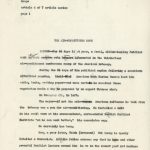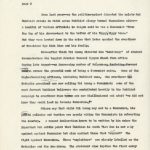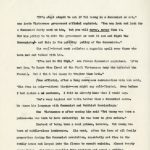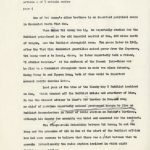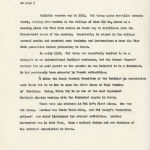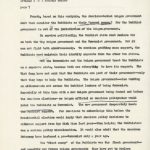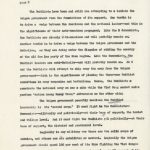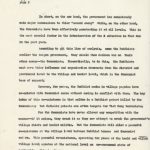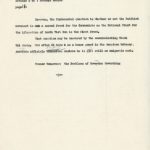1964, October, “The Air-Conditioned Monk”
deepe
article 4 of 7 article series
page 1
THE AIR-CONDITIONED MONK
SAIGON–For 64 days la st year, a frail, elfish-looking Buddhist monk in A dark saffron robe hibearn hibernated in the third-floor air-conditioned conference rooms of the American Embassy.
During the 64 days of his political asylum following a crackdown on Buddhist pagodas, khaki-Clad American Mark Marine Guards lent him radio, books, writing paper–and made certain he received three vegetarian meals a day lr prepared by an expert Chinese chef.
On November 4th, he left.
The major–if not the sole–Amnnin American influence he took from the Embassy was a yen for air-conditioning. He installed a unit in his small room at his creme-colored, curve-roofed Buddhit Buddhist Institute “so he can work better,” his associates say.
He certainly has been.
Now, a year later, Thich (Reverend) Tri Quang is openly labelled a Communist. Politic Police sources say that he has and other powerful Buddhist leaders around him ha ve in the recent past met members of the National Front for the Liberation of South Viet Nam, the political arm of the Viet Cong guerrillas.
(More)
deepe
article 41 of 7 article series
page 2
Even last year–as the politico-priest directed the celebrated Buddhist crisis in which seven Buddhist clergy burned themselves alive–a handful of Western officials in Saigon said he was a Communist “from the top of his shaven-head to the bottom of his tippy, tippy toes.” But they were hooted down in the cries that later sparked the overthrow of President Ngo Dinh Diem and his family.
Now–after Thich Tri Quang directed his “demi-coup” of student demonstrators who toppled Premier General Nguyen Khanh from office during late August–an increasing number of Saigonese, including fervent Buddnn accuse the graceful monk of being a Communist cadre. Some of the highest-ranking officers, including the Buddhist ones, who overthrew the Catholic president Diem are now calling Tri Quang a Communist; some of the most fervent Buddhist believers who contributed heavily to the Buddhist campaign to overthrow Diem herex are now disillusioned and admit “we did not know they would lead us toward Communism.“”
Others say that while Tri Quang may not be a Communist, his politi policies and tactics are openly aiding the Communists in subverting the country. A recent declaration known to be written by him makes the important but subtle point that Buddhism in South Viet Nam is not only against against Communism but also against those that “esxploit” the fight against Communism. These “exploiters” are clearly labelled as the Catholics and Americans. The statement also implies the first enemy is the Catholics and the Americans–and then the Communists.
(More)
deepe
article 4 of 7 article series
page 3
“It’s stupd stupid to ask if Tri Quang is a Communist or not,” one irate Vietnamese government official exploded. “You can look and look for a Communist Party card on him, but you will never, never find it. But his policy is to make the government so weak it can not fight the Communists,–and this is the politicy policy of the Communists.”
The small-framed monk radiates a magnetic spell over those who have met and talked with him.
“I’ve met Ho Chi Minh,” one former Communist explained. “I’ve met Gen. Vo Nguye Giap (head of the North Vietnamese army who defeated the French). But I think Tri Quang is tougher than both.”
“One official, after a long convereav conversation with him said, “His face is pale–without blookd–you might say cold-blooded. Even before I had spoken a atsentence, I felt he already knew what I would say.
“He’s very logical and talks better than a Communist cadre. He mixes his language with the Communist and Buddhist terminology.”
One Vietnamese x after seeing him said “Tri Quang was born a prince–he was born to have authority; he was born to give orders.”
Instead of being born a real prince, however, Tri Quang was born of middle-class landowners. His aunt, after the loss of all family properties during the Communist revolution, reportedly set fire to the family house and leaped into the flames to commit suicide. Almost twenty years later, Saigonese recalled this incident and noted a strking striking parallel to Tri Quang‘s tactics of having Buddhist clergy burn themselves alive in protest against the Diem regime.
deepe
article 4 of 7 article series
page 4
One of Tri Quang‘s elder brothers is an important political cadre in Communist North Viet Nam.
When hexxx Tri Quang was 13, he reportedly studied for the Buddhist priesthood in the old imperial capital of Hue, 400 miles north of Saigon, now the Buddhist stronghold area. Ten years later in 1945, after the Viet Minh Communist guerrillas seized power from the Japanese, Tri Quang went a to Hanoi, where, he later reportedly told a friend, “I studied Marxism.” At the outbreak of the French Indo-China war he fled to a Communist stronghold where he made two close friends,Hoang Trong Ba and Nguyen Dang, both of whom would be important several decadr decades later.
Last year at the time of the bloody May 8 Buddhist incident in Hue, which touched off the Buddhist crisis and overthrow of Diem, Ba was the closest advisor toDiem‘s bor brother in Hue.and Dang as chief of province reportedly ordered government troops to fire on Buddhist demonstratorsin front of radio station on Buddhi’s birthday, although his deputy for security was tried and executed for the incident.
The two20-year-old friendship between Tri Quang, Ba and Dan Dang and the presence of all in Hue at the start of the Buddhist affairs has led some sources to believe that there was a pllot between them to provoke intentionally the radio station incident in which eight Buddhists were killed.
deepe
article 4 of 7 article series
xx page 5
Reliable sources say in 1951, Tri Quang again travelled towards Hanoi, staying afew months in the village of Dien Hok Ho, known as a meeting place for Viet Minh cadres on their way to infiltrate into the French-held areas of the country. Reportedly, he stayed in the village several months and received some training and instructions v from the Viet Minh guerrillas before proceeding to Hanoi.
In early 1952, Tri Quang was reportedly invited to be a delegate to an international Buddhist conference, but the French “Surete” refused him an exit permit on the grounds he was believed to be a Communist. He had previously been arrested by French authorities.
T Later the Hanoi Central Committee of the Buddhist as Association sent Thich Tri Do to Hue to open the first class of High Studies of Buddhism. Today, Thich Tri Do is one of the most important Buddhist clerics working with the Communist regime in Hanoi.
There were six students in Tri Do‘s first class. One was Tri Quang. Another was Thich Thien Minh, now Tri Quang‘s “executive officer” and chief lieutenant for student activities. Another instructor was Le Dinh Tham, then a medical doctor and now a chairman of the Buddhist Association in Hanoi.
deepe
article 4 of 7 article series
page 6
In 1958, Tri Quang was a member of the Vietnamese Buddhist Association to attend the Internationa
Tri Quang admitted to Diem‘s brother, Can, that he had been a Communist, but had “since changed his ways.” But last year during the cle celebrated Buddhist crisis, neither Diem nor his b younger intellectual brother Nu Nhu believed him.
Long-time observers of the Viet Nam situation, however, argue that one must investigate the policies of the Buddhist leaders themselves , which have had the effect of weakening the government.
They argue that the Buddhist movement is a political movement of significant dimensions–and it is growing. Second, as a political movement, it can sur sustain and increase its mass support by being–and temporarily remaining–a movement of protest. These observers argue that the immediate enemy of the Buddhists is the Catholics, the Americans and the Saigon government–and ANY Saigon government. However, according to this line of reasoning, Buddhist leaders will paradoxically oppose the government consistently–but not enough to make it entirely collapse–until they are ready to become the Saigon government.
Third, by remaining an opposition element and hence weakin weakening the Saigon government, the Buddhist policies are aiding the policies of the Communists. Both the Buddhists and the Communist movements are hence in parallel, both directing their fire at the a common enemy, the Saigon government. The real question is whether or not the Buddhists are directed by the Communists.
deepe
article 4 of 7 article series
page 7
Fourth, based on this analysis, the American-backed Saigon government must then consider the Buddhists as their “second enemy,” for the Buddhist government is out of the jurisdiction of the Saigon government.
To survive politically, the Buddhist state must declare war on both the Sag Saigon government and the Communist government. But it can not fight both simultaneously. To continue grabbing mass support, the Buddhists must maintain their identity separate from the other two states.
ButBoth the Communists and the Saigon government treat the Buddhists as a separate state, because both are attempting to have its support. the Viet Cong have not said that the Buddhists are part of their government–only that they hope to help the Buddhists. The Saigon government–also wanting an alliance–do not accuse the Buddhist leaders of being Communist. Especially at this time with a new Saigon government being formed and before the American elections–noSaigon official or American policymaker would label the Buddhists as Communist. The new government desperately needs the Buddhist support. For Americans to acknowledge this before the Presidential election would imply that American policy decisions to withdraw support from Ngo Dinh Diem last year–thus helping the Buddhists–was a serious policy miscalculation. It would also admit that the American Embassy here harbored a pro-Communist only a year ago.
The “first enemy” of the Buddhists was the Khanh government–and possibly any future Saigon government; they have yet to declare war on the Communists in the villages and it is doubtful they will ever have the power to do so.
deepe
article 4 of 7 article series
page 8
The Buddhists have been and still are attempting to s isolate the Saigon government from the foundations of its support. One tactic is to drive a wedge between the Americans and the national leader–and this is the significance of their anti-American propaganda. Like the 2 Communists, the Buddhists are clearly abNti-American and will probably remain so. Another tactic is to drive a wedge between the Saigon government and the Catholics, as they are doing under the disguise of ridding the country of the old Can Lao party of the Diem regime. Like the Communists, the Buddhist leaders are anti-Catholic–and will probably remain so. An dAnd the Buddhists will attempt to chip away the army from the Saigon government–which is the significance of placing the three-man Buddhist committees in army companies and battalions. Hence, the Buddhists e penetrate the national army on one e side while the Viet Cong secret cadre perform “Action Among Enemy Troop” subversion on the other side.
The Saigon government possibly realizes the Buddhist leadership as its “second enemy.” It must fight kc the Commuuists– Communists–militarily and politically–at their base of support, the hamlet and village level. And it must fight the Buddhists p9l politically–at their base of support, the district and provincial level.
Logically in any military war there are two solid camps of enemies, and others are sta satellites or neutral. Logically the Saigon government should spend 100 per cent of its time fighting the Viet Cong–and vice versa. But the government now must spend up to 90 per cent of its time–during crucial moments in given localities–fighting the Buddhists instead of the Viet Cong.
deepe
a rticle 4 of 7 article series
page 9
The short-term Buddhist strategy is obviously to remain in the opposition to the government, which means they must refuse to become a significant part of the government. The Buddhists will continue this strategy until they are ready to become the government, when they have the political personalities to take it over. One thing is clear: that time is not now.
No one knows when the Buddhists wll d will decide to swallow up the Saigon government, but one may suspect their aim is the permanent constitution to becomcompleted next November. For the Buddhists, like the Communists, operate in phases. Possibly the date to watch is not November, 1964, but November, 1965.
The Buddhists already have been given major concessions by the Saigon government–and presumably they will ask for more of the same. The Buddhists within the past months have been usurping the powers of the Saigon government; they can block appointments of military corps commanders, or cabinet minu ministers.
They have already demanded from the government–and recieved–the distr destruction of police records on Buddhist leaders. This lead the Saigon police chief to gasp several moths ago, “It’s the first time in the my life I have ever heard of a police official handing over police records to Buddhist bonzes.”
During recent weeks in provincial capitals, pro-Buddhist mobs have “arrested” Can Lao party members–and turned them over to the government for prosecution. The military careers of young district chiefs and province chiefs are no longer broken by their military superiors–but by Buddhist bonzes.
deepe
article 4 of 7 article series
page10 9
In short, on the one hand, the government has consciously made major concessions to their “second enemy” while, on the other hand, the Communists have been effectively penetrating it at all levels. This is the most crucial factor int he deterioration of the i situation in Viet Nam in the past year.
According to ghi this line of analysis, once the Buddhists swallow the Saigon government, they should then declare war on their other enemy–the Communists. Theoretically, to do this, the Buddhists must move their influence and organization downwards from the district and provincial level to the village and hamlet level, which is the Communist base of support.
However, for years, the Buddhist monks in village pagodas have co-existed with Communist cadre without coming in conflict with them. They key index of this co-existence is that seldom is a Buddhist priest killed by the Communists; but Catholic priests are often targets for Viet Cong terrorists.
For the Communists have never allowed any competition with the masses–if it arises, they crush it as they now attempt to crush the government’s village chiefs and hamlet militia. But the Communists will allow a peaceful co-existence at the village level between Buddhist bonzes and Communist cadre. This peaceful co-existence, operating for years at the hamlet and vilale village level, equates at the national level an un-announced state of neutrality. This is clear.
deepe
article 4 of 7 article series
page 1011
However, the fundamental question is whether or not the Buddhist movement is not a second front for the Communists as the National Front for the Liberation of South Viet Nam is the first front.
That question may be answered by the anemic-looking Thich Tri Quang. But after 64 days i as a house guest in the American Embassy , American officialsthemselvesthere declare he is stkl still an enigmatic monk.
Tomoor Tomorrow: the Problems of Governme Governing.
-30-
Read Previous Article: 1964, October, “The “Silver” Race vs. The “Black” Race”
Read Next Article: 1964, October, “The Problems of Governing”

